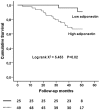The role of serum magnesium and calcium on the association between adiponectin levels and all-cause mortality in end-stage renal disease patients
- PMID: 23285003
- PMCID: PMC3527536
- DOI: 10.1371/journal.pone.0052350
The role of serum magnesium and calcium on the association between adiponectin levels and all-cause mortality in end-stage renal disease patients
Abstract
Background: Adiponectin (ADPN) is the most abundant adipocyte-specific cytokine that plays an important role in energy homeostasis by regulating lipid and glucose metabolism. Studies of the impact of ADPN on clinical outcomes have yielded contradictory results so far. Here, we examined the association of ADPN with serum magnesium (s-Mg) and calcium (s-Ca) levels and explored the possibility whether these two factors could modify the relationship between ADPN and all-cause mortality in patients with end-stage renal disease.
Methodology/principal findings: After baseline assessment, 47 hemodialysis and 27 peritoneal dialysis patients were followed- up for a median period of 50 months. S-Mg and s-Ca levels emerged as positive and negative predictors of ADPN levels, respectively. During the follow-up period 18 deaths occurred. There was a significant 4% increased risk for all-cause mortality for each 1-µg/ml increment of ADPN (crude HR, 1.04; 95% CI, 1.01-1.07), even after adjustment for s-Mg and s-Ca levels, dialysis mode, age, albumin and C-reactive protein. Cox analysis stratified by s-Mg levels (below and above the median value of 2.45 mg/dl) and s-Ca levels (below and above the median value of 9.3 mg/dl), revealed ADPN as an independent predictor of total mortality only in the low s-Mg and high s-Ca groups. Furthermore, low s-Mg and high s-Ca levels were independently associated with malnutrition, inflammation, arterial stiffening and risk of death.
Conclusions/significance: The predictive value of ADPN in all-cause mortality in end-stage renal disease patients appears to be critically dependent on s-Mg and s-Ca levels. Conversely, s-Mg and s-Ca may impact on clinical outcomes by directly modifying the ADPN's bioactivity.
Conflict of interest statement
Figures
Similar articles
-
Association of Adiponectin with High-Sensitivity C-Reactive Protein and Clinical Outcomes in Peritoneal Dialysis Patients: A 3.5-Year Follow-Up Study.PLoS One. 2015 Oct 16;10(10):e0141058. doi: 10.1371/journal.pone.0141058. eCollection 2015. PLoS One. 2015. PMID: 26474473 Free PMC article.
-
Adiponectin and cardiovascular outcomes among hemodialysis patients.Kidney Blood Press Res. 2012;35(4):247-53. doi: 10.1159/000334649. Epub 2012 Jan 26. Kidney Blood Press Res. 2012. PMID: 22286012
-
Association of serum adiponectin levels with all-cause mortality in hemodialysis patients.Intern Med. 2008;47(6):485-91. doi: 10.2169/internalmedicine.47.0614. Epub 2008 Mar 17. Intern Med. 2008. PMID: 18344634
-
Adiponectin and end-stage renal disease.Hormones (Athens). 2016 Jul;15(3):345-354. doi: 10.14310/horm.2002.1698. Hormones (Athens). 2016. PMID: 27838604 Review.
-
Paradoxical role for adiponectin in chronic renal diseases? An example of reverse epidemiology.Expert Opin Ther Targets. 2009 Feb;13(2):163-73. doi: 10.1517/14728220802658481. Expert Opin Ther Targets. 2009. PMID: 19236235 Review.
Cited by
-
New Insights into Adiponectin and Leptin Roles in Chronic Kidney Disease.Biomedicines. 2022 Oct 20;10(10):2642. doi: 10.3390/biomedicines10102642. Biomedicines. 2022. PMID: 36289903 Free PMC article. Review.
-
Adiponectin and All-Cause Mortality in Patients with Chronic Kidney Disease: A Systematic Review and Meta-Analysis.Metabolites. 2025 Mar 27;15(4):230. doi: 10.3390/metabo15040230. Metabolites. 2025. PMID: 40278358 Free PMC article. Review.
-
The Adiponectin Paradox for All-Cause and Cardiovascular Mortality.Diabetes. 2018 Jan;67(1):12-22. doi: 10.2337/dbi17-0016. Diabetes. 2018. PMID: 29263167 Free PMC article.
-
Serum magnesium, mortality, and cardiovascular disease in chronic kidney disease and end-stage renal disease patients: a systematic review and meta-analysis.J Nephrol. 2019 Oct;32(5):791-802. doi: 10.1007/s40620-019-00601-6. Epub 2019 Mar 19. J Nephrol. 2019. PMID: 30888644
-
Emperor's syndrome in the COVID-19 era: Time for patient-centered nephrology?World J Nephrol. 2021 Jan 25;10(1):1-7. doi: 10.5527/wjn.v10.i1.1. World J Nephrol. 2021. PMID: 33552939 Free PMC article. Review.
References
-
- Rabin KR, Kamari Y, Avni I, Grossman E, Sharabi Y (2005) Adiponectin: linking the metabolic syndrome to its cardiovascular consequences. Expert Rev Cardiovasc Ther 3: 465–471. - PubMed
-
- Chandran M, Phillips SA, Ciaraldi T, Henry RR (2003) Adiponectin: more than just another fat cell hormone? Diabetes Care 26: 2442–2450. - PubMed
-
- Mantzoros CS, Li T, Manson JE, Meigs JB, Hu FB (2005) Circulating adiponectin levels are associated with better glycemic control, more favorable lipid profile, and reduced (inflammation in women with type 2 diabetes. J Clin Endocrinol Metab 90: 4542–4548. - PubMed
-
- Sattar N, Wannamethee G, Sarwar N, Tchernova J, Cherry L, et al. (2006) Adiponectin and coronary heart disease. A prospective study and meta-analysis. Circulation 114: 623–629. - PubMed
-
- Pischon T, Girman CJ, Hotamisligil GS, Rifai N, Hu FB, et al. (2004) Plasma adiponectin levels and risk of myocardial infarction in men. JAMA 291: 1730–1737. - PubMed
MeSH terms
Substances
LinkOut - more resources
Full Text Sources
Medical
Research Materials


